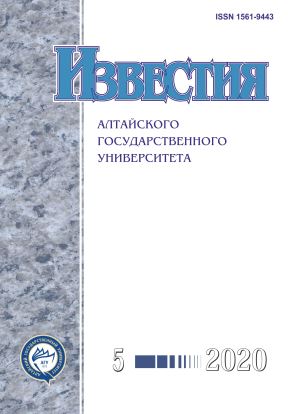Urban and Rural Population in the Barnaul Parishes in the Second Half of the 18th - 19th Centuries
УДК 94(571.150):930 ББК 63.3(2Рос-4Алт)53+63.2
Abstract
The article focuses on the analysis of the size of Orthodox parishes in Barnaul as well as the dynamics of the proportion of urban and rural population in the second half of the 18th - 19th centuries. It is concluded that there were four Orthodox parishes in Barnaul. By the end of the 18th century, the population of 24 villages was attributed to them, from 1808 - 29, by the mid-20s of the 19th century the parish territory reached its maximum size and included 33 villages. The population of rural areas in urban parishes increased during the first half of the 19th century. The indicator reached its maximum values by 1846 (51.6%). The increase was associated both with an increase in the number of villages assigned to the churches of Barnaul, and with an increase in the number of inhabitants in them. Since the end of the 1840s, with the beginning of active church building in Altai, the “area” and the number of rural population in urban parishes began to decline. The urban population was unevenly distributed between parishes. The proportion of the townspeople of the Peter and Paul Church among other parishes of Barnaul until 1860 was more than 70%, later it decreased to 34%. The clergy, built in the 1860s of the Intercession Church, "served" an average of 32% of the city's population. In the first half of the 19th century, 17% and 9% of the townspeople were assigned to the Zakharievskaya and Odigitrievskaya churches. In subsequent years, the figures were 27% and 7%.
Downloads
Metrics
References
Зольникова Н.Д. Сибирская приходская община в XVIII веке. Новосибирск, 1990.
Адаменко А.М. Приходы Русской Православной Церкви на юге Западной Сибири в XVII — начале XX века. Кемерово, 2004.
Религиозный ландшафт Западной Сибири и сопредельных регионов Центральной Азии. Т. 1: Поздняя древность - начало ХХ в. : колл. монография / отв. ред. П.К. Дашковский. Барнаул, 2014.
Дворецкая А.П., Терскова А.А., Хаит Н.Л. Православная церковь и население Приенисейской Сибири. 1700-1919 гг. : монография. Красноярск, 2018.
Владимиров В.Н., Силина И.Г., Чибисов М.Е. Приходы Барнаульского духовного правления. Барнаул, 2006.
Дулов А.В., Санников А.П. Православная Церковь в Восточной Сибири в XVII - начале XX века. Иркутск, 2006.
Цысь О.П. Духовные правления как звено церковного управления на Тобольском Севере в 1810-1860-х гг. // Вестник Православного Свято-Тихоновского гуманитарного университета. Серия II: История. История Русской Православной Церкви. Вып. 75. 2017.
Ивонин А.Р. Западносибирский город в последней четверти XVIII - 60-х гг. XIX в. (Опыт историко-демографического исследования). Барнаул, 2000.
Скубневский В.А., Гончаров Ю.М. Города Западной Сибири во второй половине XIX - начале XX в. Ч. I: Население. Экономика. Барнаул, 2003.
Владимиров В.Н., Сарафанов Д.Е. Информационные технологии в изучении метрических книг (население Барнаула в конце XVIII - начале XX в.) : монография. Барнаул, 2013.
Документы по истории церквей и вероисповеданий в Алтайском крае (XVII - начало ХХ в.) / Управление архивного дела Администрации Алтайского края. Барнаул, 1997.
Контев А.В. История Алтайского края XVIII-XIX веков : учебник для вузов. Барнаул, 2017.
Контева О.Е. 225 лет со дня открытия города Барнаула и учреждения Барнаульского магистрата // Барнаул на рубеже веков: итоги, проблемы, перспективы : материалы региональной научно-практической конференции, посвященной 275-летию Барнаула. Барнаул, 2005.
Соболева Т.Н. Горный город Барнаул // Барнаул : энциклопедия. Барнаул, 2000.
Российский государственный исторический архив (РГИА). Ф. 796. Оп. 440. Д. 720.
Полное собрание законов Российской империи. Первое собрание (ПСЗРИ-I) Т. VI. №4072.
ПСЗРИ-I. Т. XX. №14807.
Государственный архив Томской области (ГАТО). Ф. 170. Оп. 1. Д. 75.
ГАТО. Ф. 170. Оп. 1. Д. 1288.
Государственный архив Алтайского края (ГААК). Ф. 26. Оп. 1. Д. 306.
ГААК. Ф. 26. Оп. 1. Д. 307.
ГААК. Ф. 26. Оп.1. Д. 310.
ГААК. Ф. 26. Оп. 1. Д.311.
ГАТО. Ф. 170. Оп. 1. Д. 177.
ГАТО. Ф. 170. Оп. 1. Д. 239.
ГАТО. Ф. 170. Оп. 1. Д. 565.
Сарафанов Д.Е. Изучение территории городских приходов Сибири на примере Барнаула конца XVIII - начала XIX вв. // Информационный бюллетень Ассоциации «История и компьютер». №43: материалы Международной научной конференции «Геоинформационные системы и технологии в исторических исследованиях». Барнаул, 2015.
Сарафанов Д.Е., Чибисов М.Е. Соотношение численности городского и сельского населения в церковных приходах Бийска в XIX в. // Исторический ежегодник. Новосибирск, 2010.
Izvestiya of Altai State University is a golden publisher, as we allow self-archiving, but most importantly we are fully transparent about your rights.
Authors may present and discuss their findings ahead of publication: at biological or scientific conferences, on preprint servers, in public databases, and in blogs, wikis, tweets, and other informal communication channels.
Izvestiya of Altai State University allows authors to deposit manuscripts (currently under review or those for intended submission to Izvestiya of Altai State University) in non-commercial, pre-print servers such as ArXiv.
Authors who publish with this journal agree to the following terms:
- Authors retain copyright and grant the journal right of first publication with the work simultaneously licensed under a Creative Commons Attribution License (CC BY 4.0) that allows others to share the work with an acknowledgement of the work's authorship and initial publication in this journal.
- Authors are able to enter into separate, additional contractual arrangements for the non-exclusive distribution of the journal's published version of the work (e.g., post it to an institutional repository or publish it in a book), with an acknowledgement of its initial publication in this journal.
- Authors are permitted and encouraged to post their work online (e.g., in institutional repositories or on their website) prior to and during the submission process, as it can lead to productive exchanges, as well as earlier and greater citation of published work (See The Effect of Open Access).








